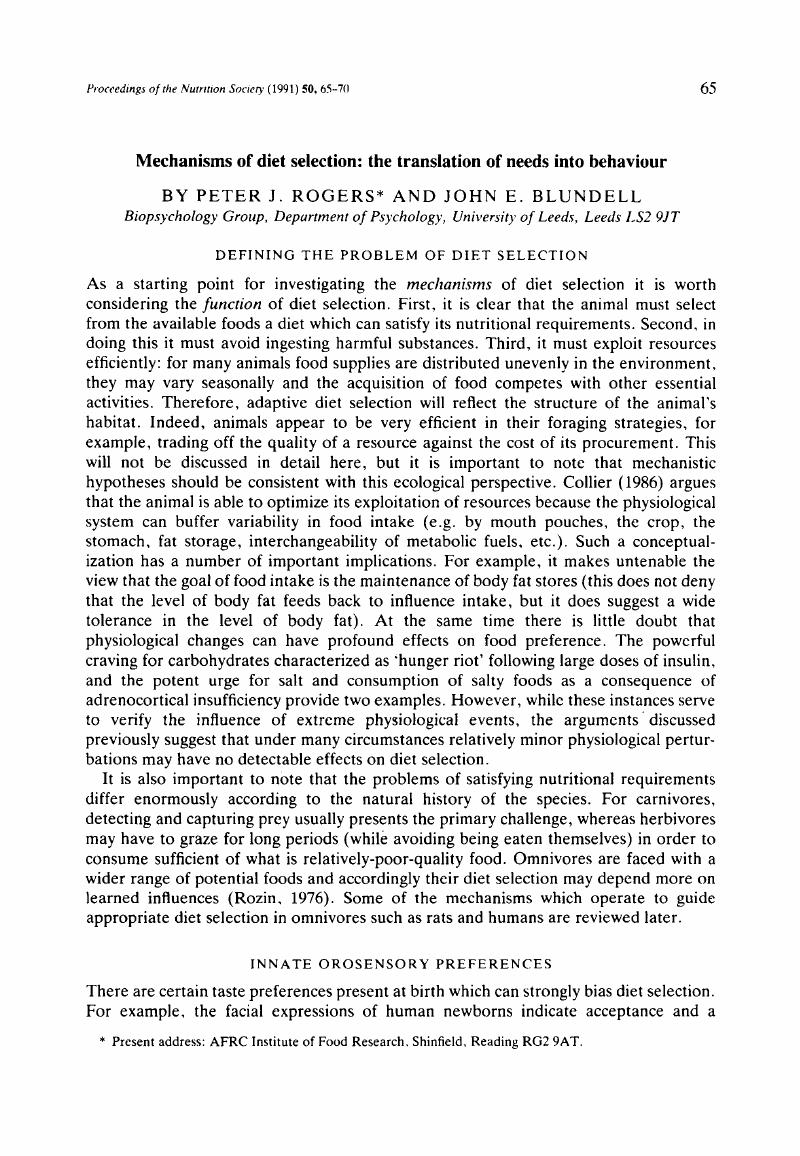Crossref Citations
This article has been cited by the following publications. This list is generated based on data provided by Crossref.
Forbes, J.M.
and
Shariatmadari, F.
1994.
Diet selection for protein by poultry.
World's Poultry Science Journal,
Vol. 50,
Issue. 1,
p.
7.
Roberts, Todd J.
Azain, Michael J.
Douglas White, B.
and
Martin, Roy J.
1995.
Rats Treated with Somatotropin Select Diets Higher in Protein.
The Journal of Nutrition,
Vol. 125,
Issue. 10,
p.
2669.
Covasa, M.
and
Forbes, J. M.
1995.
Selection of foods by broiler chickens following corticosterone administration.
British Poultry Science,
Vol. 36,
Issue. 3,
p.
489.
Gill, B. P.
Onibi, G. E.
and
English, P. R.
1995.
Food ingredient selection by growing and finishing pigs: effects on performance and carcass quality.
Animal Science,
Vol. 60,
Issue. 1,
p.
133.
Mok, Elise
and
Thibault, Louise
1998.
Effect of Diet Textural Characteristics on the Temporal Rhythms of Feeding in Rats.
Physiology & Behavior,
Vol. 65,
Issue. 4-5,
p.
893.
Day, Jon E. L.
Kyriazakis, Ilias
and
Rogers, Peter J.
1998.
Food choice and intake: towards a unifying framework of learning and feeding motivation.
Nutrition Research Reviews,
Vol. 11,
Issue. 1,
p.
25.
S̨ahin, Ahmet
Keskin, Mahmut
Biçer, Osman
and
Gül, Sabri
2003.
Diet selection by Awassi lambs fed individually in a cafeteria feeding system.
Livestock Production Science,
Vol. 82,
Issue. 2-3,
p.
163.
Ettle, T.
and
Roth, F. X.
2004.
Specific dietary selection for tryptophan by the piglet1.
Journal of Animal Science,
Vol. 82,
Issue. 4,
p.
1115.
Ettle, T.
and
Roth, F. X.
2004.
Specific dietary selection for tryptophan by the piglet1.
Journal of Animal Science,
Vol. 82,
Issue. 4,
p.
1115.
Finlayson, Graham
King, Neil
and
Blundell, John E.
2007.
Liking vs. wanting food: Importance for human appetite control and weight regulation.
Neuroscience & Biobehavioral Reviews,
Vol. 31,
Issue. 7,
p.
987.
Blundell, John E.
Finlayson, Graham
and
Halford, Jason C. G.
2009.
Clinical Obesity in Adults and Children.
p.
134.
de Brito-Ashurst, I.
Perry, L.
Sanders, T. A. B.
Thomas, J. E.
Yaqoob, M. M.
and
Dobbie, H.
2011.
Barriers and facilitators of dietary sodium restriction amongst Bangladeshi chronic kidney disease patients.
Journal of Human Nutrition and Dietetics,
Vol. 24,
Issue. 1,
p.
86.
Wolf, Nathan
Newsome, Seth D.
Peters, Jacob
and
Fogel, Marilyn L.
2015.
Variability in the routing of dietary proteins and lipids to consumer tissues influences tissue‐specific isotopic discrimination.
Rapid Communications in Mass Spectrometry,
Vol. 29,
Issue. 15,
p.
1448.
Visscher, Christian
Klingenberg, Linus
Hankel, Julia
Brehm, Ralph
Langeheine, Marion
and
Helmbrecht, Ariane
2018.
Feed Choice Led to Higher Protein Intake in Broiler Chickens Experimentally Infected With Campylobacter jejuni.
Frontiers in Nutrition,
Vol. 5,
Issue. ,
Zhang, Shou-Dong
Lin, Gong-Hua
Han, Ji-Ru
Lin, Yu-Wei
Wang, Feng-Qing
Lu, De-Chen
Xie, Jiu-Xiang
and
Zhao, Jin-Xin
2022.
Digestive Tract Morphology and Gut Microbiota Jointly Determine an Efficient Digestive Strategy in Subterranean Rodents: Plateau Zokor.
Animals,
Vol. 12,
Issue. 16,
p.
2155.
Li, Dianwei
Zhang, Chengzhi
Cao, Yuwei
Gao, Ming
Chang, Shiqi
Xu, Menghao
Jin, Zhimin
and
Ni, Hongwei
2023.
Food preference strategy of four sympatric rodents in a temperate forest in northeast China.
ZooKeys,
Vol. 1158,
Issue. ,
p.
163.
Peyton, Michael S.
Kinney, Kealohanuiopuna M.
Knox, Sarah
Tredennick, Grace
and
Hotchkiss, Sara
2024.
Dietary Niche Variation in an Invasive Omnivore: The Effects of Habitat on Feral Pig Resource Use in Hawai‘i.
Ecology and Evolution,
Vol. 14,
Issue. 10,
Gan, Lin
Sun, Jiahui
and
Li, Hong
2025.
Effects of hormones and digestive tract morphology on personality-driven foraging behaviour in the turtle Mauremys reevesii.
Animal Behaviour,
Vol. 221,
Issue. ,
p.
123069.



